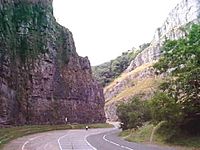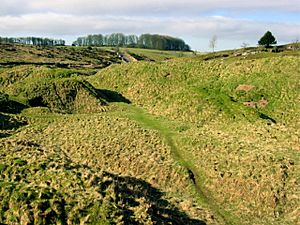Cheddar Complex facts for kids
| Site of Special Scientific Interest | |
 |
|
| Area of Search | Somerset |
|---|---|
| Coordinates | 51°16′51″N 2°46′06″W / 51.28082°N 2.76844°W |
| Interest | Biological and Geological |
| Area | 441.3 hectares (4.413 km2; 1.704 sq mi) |
| Notification | 1952 |
The Cheddar Complex is a very special natural area in Somerset, England. It covers about 441 hectares (that's like 1,090 football fields!). This area is protected because it has amazing plants, animals, and unique geological features. It's officially called a Site of Special Scientific Interest (SSSI), which means it's super important for nature and science.
This large protected area includes the famous Cheddar Gorge. It also stretches north-east towards Charterhouse in the Mendip Hills. The Cheddar Complex has been protected since 1952. It brings together four smaller protected sites into one big one. Parts of this land are owned by the National Trust and managed by the Somerset Wildlife Trust.
Contents
Amazing Nature and Wildlife
The Cheddar Complex is home to many different natural places. You can find open grasslands, rocky areas with small shrubs, and ancient woodlands. These different habitats support a wide variety of life.
Rare Plants
This area is especially important for its rare plants. There are four types of plants here that are found almost nowhere else in the country!
- Little Robin (Geranium purpureum)
- Cheddar Pink (Dianthus gratianopolitanus)
- Cheddar Bedstraw (Galium fleurotii)
The Cheddar Pink and Cheddar Bedstraw are extra special. They are found only in the Cheddar area! There are also fifteen other plant species that are nationally scarce.
Incredible Geology and Caves
The Cheddar Complex is a fantastic place for studying karst landscapes. Karst is a type of land shaped by dissolving limestone rock. This area has many caves and is important for finding ancient animal fossils.
Cheddar Gorge: Britain's Biggest Gorge
Cheddar Gorge is the largest gorge in Britain. It's probably the most famous limestone feature in the country. A gorge is a deep, narrow valley with steep sides. This one was formed by a river over two million years! Its history shows how the environment changed a lot during the Pleistocene Ice Age.
Exploring Cheddar Caves
The caves in Cheddar are fascinating. Some caves still have water flowing through them today. Others are "fossil" caves, meaning the water has stopped flowing. Scientists study the active caves to understand how water moves through the rock.
The Charterhouse area also has important caves. These include four large swallet caves. Swallets are places where a stream disappears underground. These caves show how the land developed during the Ice Age in the Mendip Hills. Sun Hole Cave is another important site. It contains fossils of many different animals from the end of the last Ice Age.
Types of Rock
You can see several types of limestone in the Gorge and nearby areas. These include Clifton Down Limestone and Cheddar Oolite. Pale grey Burrington Oolite can also be seen around Black Rock Gate.
Ancient Lead Mining
The Charterhouse area is also very important for its history. It has the best examples of old lead mining sites in the Mendips. People mined lead here from before Roman times all the way up to the 1800s. You can still see the marks on the land from this ancient mining.
Somerset Wildlife Trust Nature Reserves
Several parts of the Cheddar Complex are nature reserves. These are managed by the Somerset Wildlife Trust. They include:
- Black Rock
- Bubworth Acres
- GB Gruffy
- Long Wood
- Mascall's Wood
- Middledown
- Ubley Warren
- Velvet Bottom
Black Rock Reserve
The Black Rock reserve covers about 181 acres. It has woodlands, limestone grasslands, and an old quarry.
Long Wood Reserve
Long Wood is about 47 acres of ancient woodland. It includes the Longwood Swallet, where a stream disappears underground. This wood used to belong to monks a long time ago.
Velvet Bottom Reserve
In Roman times, people mined lead in Velvet Bottom. You can still see the remains of circular pits called "buddle pits." These were used to wash the lead ore. There are also piles of black, shiny slag. This is waste material left over from melting the lead. Today, Velvet Bottom is mostly rough grassland with some trees and shrubs.
GB Gruffy Reserve
GB Gruffy is a 17-acre area of grassland. It sits on top of the GB Cave system.
Ubley Warren Reserve
Ubley Warren is an 86-acre site. It was also heavily affected by lead mining until the 19th century.


